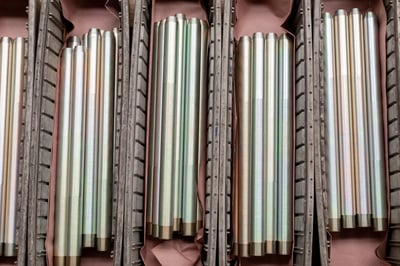Why is Zinc the 4th Most Widely Consumed Metal?

Zinc is regularly used in electroplating – more often than you think. Zinc has real benefits and disadvantages, so it pays to understand what those are.
Zinc plating is often used on small parts such as fasteners, crank handles, springs and other hardware items.
Properties of Zinc Plating
Zinc is now the 4th most widely consumed metal in the entire world; nearly one half of all zinc produced is used to protect steel and iron from rusting. Like many coatings Zinc is used to keep out the moisture that can significantly speed up the corrosion process.
- The normal zinc-plated coating is dull gray in color with a matte finish, but whiter coatings can be produced, depending on the process.
- Zinc plating comes in different colors, but each of the colors can result from the type of plating formulation used.
- Bright zinc plated components compete against bright nickel and chromium as a less expensive coating
- The coating is often lacquered (organic or water base) to preserve the appearance and extend its service life.
- Zinc dissolves easily in acids and alkalis, so it is unsuitable for use in the food industry.
- Zinc is capable of alloying with other metals as an electrodeposit as well
What are the physical properties of zinc?
Atomic Number: 30
Atomic Weight: 65.38
Appearance: Hard blue/white metal
Melting Point: 419° Celsius
Boiling Point: 907° Celsius
Types of Zinc Plating Solutions
Zinc plating can be Cyanide based, Alkaline based or Acid based.
Cyanide based solutions (now represent less than 5% in the market) and can be used in a range of concentrations: High cyanide solution (around 100g/l NaCN), medium cyanide solutions (50g/l NaCN) and low cyanide solutions (10g/l NaCN)
Advantages and Disadvantages of Cyanide based Zinc Solutions
Advantages
- Simple chemistry-easily available
- Good covering power & throwing power
- Easily obtained with good additive systems
- Tolerant to inferior preplate cleaning (due to cyanide)
Disadvantages
- Very toxic
- Expensive waste treatment
- Danger of hydrogen embrittlement
- Possible zinc laydown on high carbon steel
- Cannot be used on cast iron
Alkaline, Non-Cyanide, Zinc Solutions
Non-Cyanide, alkaline zinc solutions are a cheap and reliable process. They have reduced the market share for Cyanide & Acid Zinc solutions for both rack and barrel.
It has almost the same characteristics as cyanide, but without the toxicities of it.
One of the greatest strengths of alkaline cyanide-fee plating is the ability to plate in a deep, low current density recesses without over-plating the outside, high current density edges, this process is ideal for post paint and powder applications.
Of the three types of zinc plating, alkaline cyanide-free is the least inexpensive, and the electrolyte is very simple to operate.
Acid Chloride Zinc
The acid chloride zinc deposit is described as being nickel-chrome like in appearance with extremely deep brightness, and having a smooth and level surface. The deposit produces a truer clear, blue chromate finish (less yellow than alkaline cyanide free) due to chromate film thickness and formation. The deposit lacks the porosity of alkaline cyanide-free zinc.
How are zinc anodes used?
Zinc Anodes can be cast anode bars or more common is zinc balls which are held in steel cages.
If a bath is idle for long periods, then the zinc will slowly dissolve and increase the zinc content of the bath.
It is not unusual to add zinc salts due to drag out, this being very true for barrel plating where drag out can be high. In rack plant where drag out is lower, the zinc content can rise.
Zinc is fairly tolerant to metallic contamination. Lead, cadmium, nickel, and copper can all lead to darkening of the deposit in the low current density but can easily be removed.
This can be removed using a Sodium Sulphide solution (also known as the doctor solution). This solution will suppress lead and cadmium as an insoluble sulphide. The cadmium tends to come from the zinc anodes as the two metals live together quite happily. Zinc anodes will always have a trace of cadmium, pure zinc without cadmium will be too expensive.
Zinc, having a low cost and great corrosion resistance properties, make it a very attractive finish for paint and powder coating. Besides its low cost, it is a lightweight solution with improved durability, it is environmentally friendly because it can be reused and recycled, and it improves how the base metal looks; what else can you ask for? There are many plating plants around the world that offer zinc plating, and the plating lines look like this Zinc Barrel and Rack Plating Line Riley Industries sold.
Machines & equipment for sale
- Surface Treatment
- Cleaning & Degreasing
- Polishing & Belt Linishing
- Mass Finishing
- Ovens & Furnaces
- Process Cooling
- Shot Blasting
- Dust & Fume Extraction
- Air Compressors
- Rectifiers & Transformers
- Miscellaneous
- Latest Stock
- Special Offers
- Direct From Site Clearances
- Auctions
- Brand New Machines
- Available Immediately
- Sell Your Machine
Machine Alert
Get the latest machines emailed directly to you as they become available to buy online. Sign Up Now

